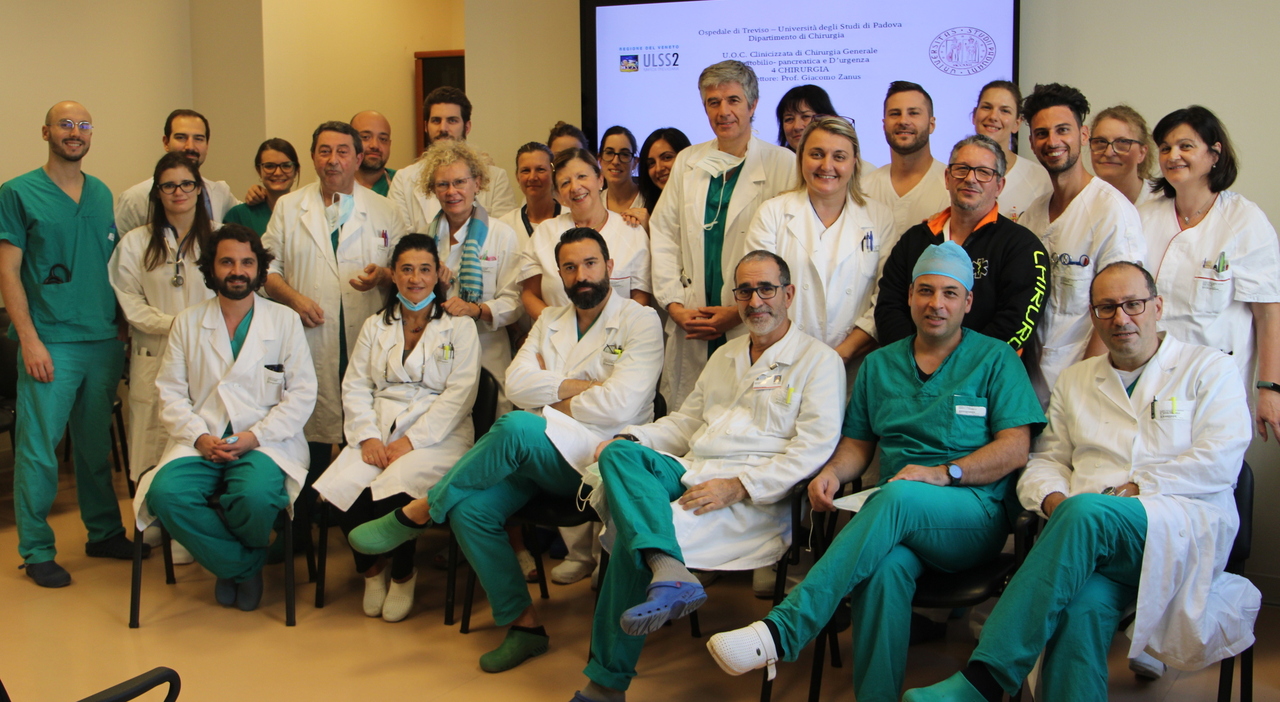TREVISO – Extraordinary surgery at Ca’ Foncello hospital, 75% of the liver removed from a forty-year-old with 11 liver metastases. Performed by Surgery 2 directed by Prof Giacomo Zanus, the operation had a positive outcome despite the fact that the patient was found to be inoperable from the first evaluation. The 40-year-old sub-occlusive rectal tumor had led to the formation of numerous metastases that had invaded the liver in its entirety. The man was therefore subjected to chemotherapy treatment with extraordinary clinical response, disappearance of the lesion in the rectum and reduction of liver lesions. Treatment of the rectum was completed with targeted radiotherapy. Radiological diagnostics and endoscopic study have allowed the accurate evaluation of the response of the tumor to chemo-radiotherapy treatment. «A round of applause to Prof. Zanus’s team and to all the professionals, and there were so many, who made it possible to successfully complete this complex intervention – commented the general manager, Francesco Benazzi -. The result obtained confirms the importance of synergy between Operating Units. With regard to the technological equipment our investments are continuous and the transition to Cittadella will allow a further leap in quality».
FURTHER INFORMATION
From chemotherapy to surgery: 11 tumor lesions removed
The chemotherapy response of the 40-year-old made it possible to reduce the tumor load within the liver with evidence of a liver volumetric quantity of disease-free liver of 25%. Hence the possibility of pruning at term the surgery, performed in a single session, which was particularly complex due to the need to clear all 11 tumor lesions while leaving an adequate amount of healthy liver to ensure patient survival. The post-operative course was without complications discharge on the sixth postoperative day. «This case represents – underlines Prof. Zanus – a further demonstration of the therapeutic efficacy of the active collaboration between the hospital of Treviso, the University of Padua and institutions in a cutting-edge healthcare model like the Venetian one. It’s about a virtuous team work where university research and hospital assistance have guaranteed a very important therapeutic success: a winning combination that projects Treviso into the future of translational and precision medicine. The articulated assistance process has made it possible to transform a young family man, inoperable cancer patient with a poor prognosis in a patient with prospects of radical cure and concrete survival. The hub hospital of Treviso has guaranteed the optimal management of all the phases of the care path».
The details of the intervention
«In the first place, the precision radiological diagnostics performed by Dr. Morana were fundamental for the identification of the number, site, anatomical relationships and therapeutic response of the tumor lesions and the endoscopic diagnostics performed by the team of Dr. Benvenuti for the evaluation of the response of the tumor rectal to chemo-radiotherapy treatment – explains the prof – The subsequent oncological treatment performed by Dr. Favaretto’s team has mradically changed the patient’s clinical history making it surgically curable after 6 cycles of chemotherapy while the radiotherapy performed by Dr Ferrarese’s group stabilized the recovery of the rectum. There three-dimensional reconstruction and the definition of the hepatic volumes determined by Dr Barbisan allowed the accurate pre-operative planning of the surgical strategy. The intraoperative management of Dr. Zanatta’s anesthesiological team made it possible to optimally overcome the most critical phases of the surgery with particular reference to the very delicate manipulation of the large blood vessels without having to stay in intensive care. The resective surgery on the liver, in which I was assisted by Dr Brizzolari and Dr Scopelliti, was particularly complex. He required the use of the very high intraoperative technology available in the Ca Foncello operating room: from the microsurgical dissection with ultrasound, to bipolar coagulationto thermoablation with microwaves using ultrasound-guided intraparenchymal navigation. This equipment has allowed us to apply the most advanced techniques of liver resection with parenchymal sparing, removing all malignant lesions with over 75% of the liver, distributed in all liver segments while ensuring the integrity of the healthy remnant liver. A volumetrically very small portion of the liver was spared, less than 25%, but sufficient for the survival of the patient according to the protocols of the most advanced surgical research. With these premises, the post-operative course was linear and in six days, thanks to the application of the ERAS protocol to encourage post-surgical recovery, the patient was discharged and followed up at home with telemedicine.
But still all of this would not have been possible if there hadn’t been both assistance and human availability on the part of all the nursing staff and the operating room and ward health workers”.
Luca Zaia’s comment
«The Venetian health care of excellence does not go on vacation and, indeed, achieves striking results, as in the case of the patient who, at the Cà Foncello in Treviso, had eleven tumor metastases removed from the liver in a single operation. I congratulate the Head Doctor Giacomo Zanus and his entire team of Surgery 2», comments the governor of Veneto, Luca Zaia. «Not even so long ago, with those pathologies in progress, this young patient would have been considered unrecoverable – adds Zaia – but for Zanus, his team and the progress of medicine in the Veneto, absolutely not. The discharge times were also amazing: six days after the operation, the young patient was already at home. Another example of how our doctors and hospitals face every battle without ever giving it up, and often winning it».
